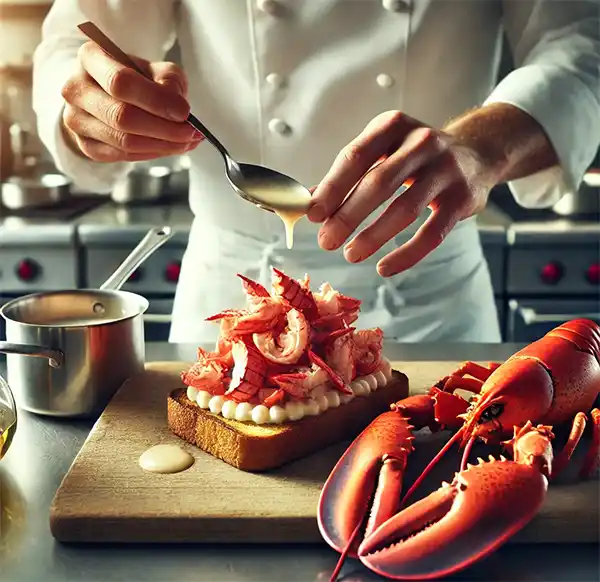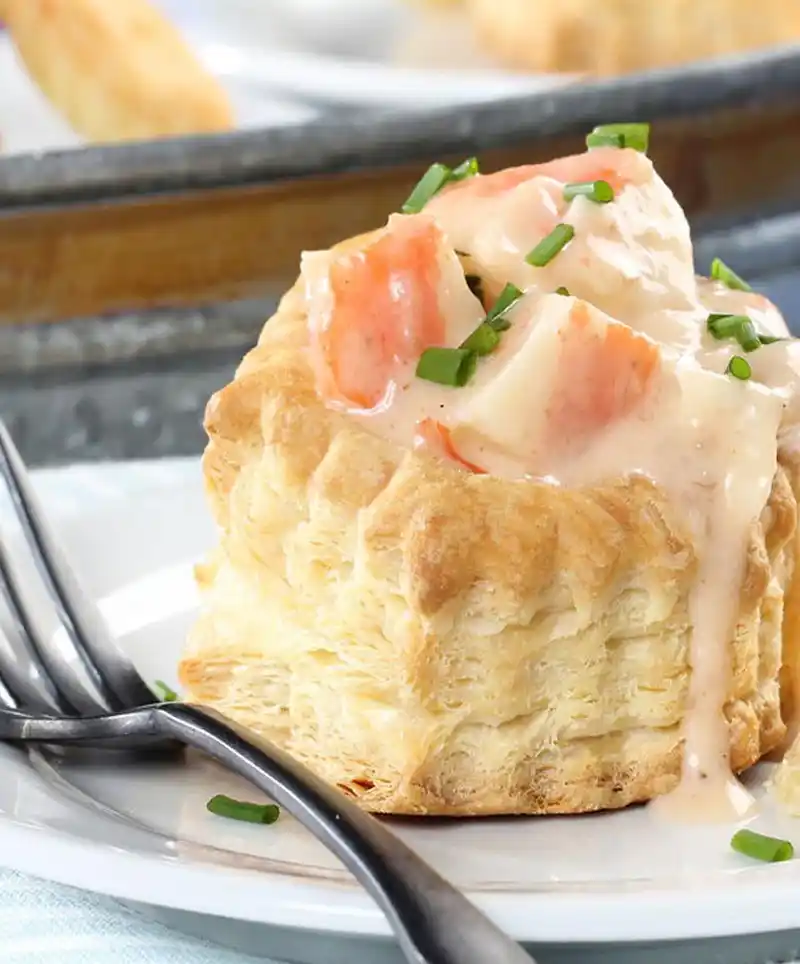A Decadent Dive Into Creamy Crustacean Glory
Every March 25th, we pause our healthy eating resolutions (again) and raise a buttery fork to National Lobster Newburg Day, a holiday dedicated to one of the richest, creamiest, and most luxurious seafood dishes ever to grace a chafing dish. This is not diet food. This is celebration food—opulent, indulgent, and with a backstory as saucy as the dish itself.
So... What Is Lobster Newburg?
Imagine chunks of tender lobster bathed in a velvety sauce made from butter, egg yolks, cream, and a glug of sherry or cognac for good measure. Now imagine that over toast points, puff pastry, or even spooned over rice if you feel casual but classy. That, my friend, is Lobster Newburg—a dish that says, “I’ve made some choices today, and all of them involve heavy cream.”
It’s rich. It’s elegant. It’s the culinary equivalent of wearing a velvet smoking jacket while reading poetry to your goldfish.
A Brief and Boozy History
The story of Lobster Newburg begins, as many great culinary tales do, with a well-to-do gentleman, a good amount of liquor, and a dash of ego.
In the 1870s, Captain Ben Wenberg, a wealthy sea captain who made his fortune in the fruit trade—bananas and pineapples, not treasure chests—was a regular patron of Delmonico’s, the swanky New York City restaurant known for catering to the upper crust. Captain Wenberg, clearly no stranger to good eating, claimed to have discovered a delectable lobster preparation during his travels and demanded (with the confidence only a man with a mustache and monocle could summon) that the Delmonico’s chef allow him into the kitchen to demonstrate it.
He did. And it was a hit.
Wenberg’s recipe included lobster meat sautéed in butter, enriched with cream and egg yolks, and finished with a splash of sherry or Madeira wine. The final result was rich, refined, and—according to those who tasted it—absolutely unforgettable. Delmonico’s promptly put it on the menu as “Lobster à la Wenberg.” Patrons loved it. Wenberg basked in culinary glory. All was well.
Until it wasn’t.
At some point, Wenberg and Charles Delmonico, head of the restaurant at the time, had a falling out. The exact details are a bit fuzzy (and possibly wine-soaked), but it was dramatic enough that Delmonico’s yanked the dish from the menu entirely—because nothing says high society like a petty kitchen feud.
 But here’s where it gets clever: the dish was just too popular to stay gone. Customers demanded it back. So rather than admit defeat, the Delmonico’s team took the high road... by taking the low road. They simply rearranged the letters of Wenberg’s name and voilà—Lobster Newburg was born.
But here’s where it gets clever: the dish was just too popular to stay gone. Customers demanded it back. So rather than admit defeat, the Delmonico’s team took the high road... by taking the low road. They simply rearranged the letters of Wenberg’s name and voilà—Lobster Newburg was born.
Same dish. Same ingredients. New name. Slightly more spite.
The renamed recipe remained a star on the Delmonico’s menu and soon spread to fine restaurants across the country. It became a fixture at fancy dinner parties, hotel banquets, and luxury cruise ship menus—basically anywhere the words “claw meat” and “sherry” were spoken with flair. By the early 20th century, Lobster Newburg was practically the king of indulgent American seafood dishes, wearing a creamy crown and reigning over everything from puff pastry shells to toast points.
So, while the name might have changed out of pique, the dish’s legacy is one of high flavor, drama, and cholesterol—and we wouldn’t have it any other way.
The Anatomy of Indulgence
Here’s what makes Lobster Newburg a showstopper:
Lobster meat – tender, sweet, and best when fresh (though frozen will do in a pinch if you whisper your apologies).
- Butter – don’t skimp. This dish is legally required to be at least 35% butter. (Okay, not really, but it feels right.)
- Cream – heavy cream only, because milk just isn’t going to cut it here.
- Egg yolks – they give the sauce that silky texture you’ll be dreaming about later.
- Sherry or Cognac – a little booze for depth, warmth, and the satisfying feeling of sophistication.
- Seasonings – usually salt, pepper, cayenne, and a hint of nutmeg if you’re feeling adventurous.
Combine everything into a luscious sauce, gently fold in the lobster, and serve it piping hot. It’s not hard to make—it just feels like it should require a tuxedo and a classical violinist in the corner.
How to Celebrate National Lobster Newburg Day
Sure, it’s not a federal holiday (yet), but that doesn’t mean you can’t honor National Lobster Newburg Day with gusto. Whether you’re a die-hard foodie, a history buff, or just someone looking for an excuse to drown something in cream and butter, there are plenty of delicious ways to mark the occasion. No need for black tie—just a hearty appetite and maybe a nap scheduled afterward.
- Make it at home – Recipes are everywhere, and once you get over the shock of using an entire stick of butter, you’ll be fine.
- Order it from a restaurant – Not every place has it on the menu, but if you find one that does, reward them with your undying loyalty and tip extra.
- Post your plate – Share your Lobster Newburg on social media with the hashtag #LobsterNewburgDay. Bonus points if you pair it with a glass of sherry and a smug expression.
- Throw a vintage dinner party – Think 19th-century glam, complete with candlelight, champagne, and a dramatic reading of the Wenberg-Newburg saga.
Fun Facts to Impress No One But Yourself
The original Delmonico’s, where the dish debuted, also claims to be the birthplace of Baked Alaska and Eggs Benedict. Clearly, they knew how to brunch before brunch was cool.
Lobster Newburg was once a staple on cruise ships, old-school hotel menus, and retro cookbooks—right between aspic and beef Wellington.
If made correctly, the dish clocks in at roughly one million calories. (Okay, more like 500–700, but who’s counting?)
A Toast to Cream, Lobster, and Slight Pettiness 🥂
National Lobster Newburg Day is more than just a celebration of flavor—it’s a nod to culinary creativity, old-school dining elegance, and the drama that only a lobster dish with a name-change backstory can provide. So whether you’re feasting at a fine restaurant or attempting it at home in your PJs, embrace the richness, the history, and the joy of eating like a sea captain who once stormed a kitchen in Manhattan.
Bon appétit, and long live the lobster!
Please Share our Content






 But here’s where it gets clever: the dish was just too popular to stay gone. Customers demanded it back. So rather than admit defeat, the Delmonico’s team took the high road... by taking the low road. They simply rearranged the letters of Wenberg’s name and voilà—Lobster Newburg was born.
But here’s where it gets clever: the dish was just too popular to stay gone. Customers demanded it back. So rather than admit defeat, the Delmonico’s team took the high road... by taking the low road. They simply rearranged the letters of Wenberg’s name and voilà—Lobster Newburg was born.








 "Sláinte!" is a traditional Irish expression used as a toast, equivalent to "Cheers!" in English.
"Sláinte!" is a traditional Irish expression used as a toast, equivalent to "Cheers!" in English.